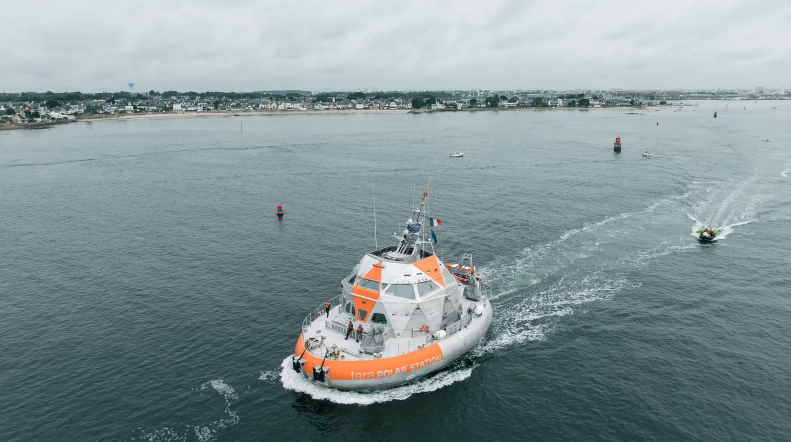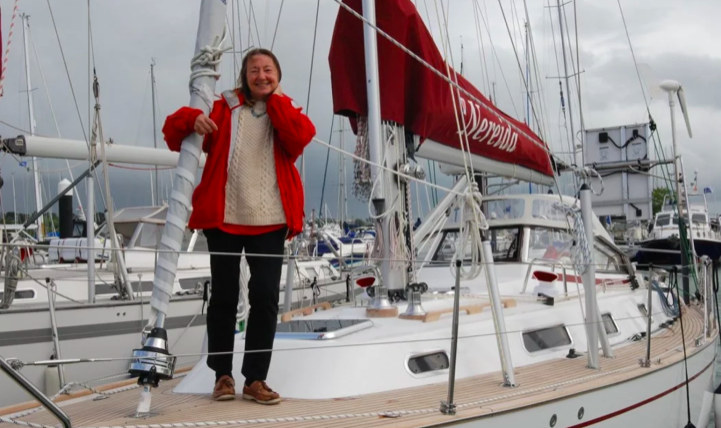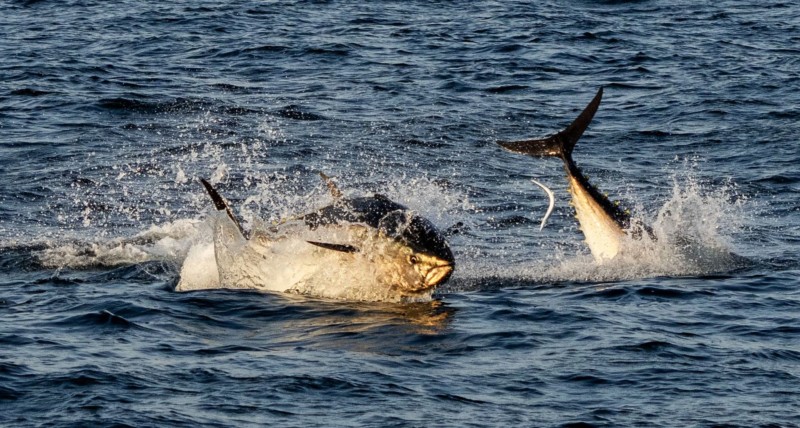After five long years of design and eighteen months of construction, the Tara Polar Station is now ready to face the Arctic waters. It will embark on its journey in 2026, drifting amidst the Arctic ice.
The Tara Polar Station was built in Cherbourg at Constructions Mécaniques de Normandie (CMN), following a year and a half of construction. It was first launched in October 2024 before arriving at its home port in Lorient in mid-April 2025. A true technical feat, this vessel, reminiscent of a spaceship, looks like it came straight out of a science fiction movie: its 110-ton aluminum oval hull forms a large floating ring around a polar dome pierced with portholes. The polar station is the joint work of architect Olivier Petit and the Tara Ocean Foundation. Since 2003, the foundation has actively worked to study and protect the ocean through scientific expeditions around the world, notably using its first ship, the famous schooner Tara.
Recently, the Tara Polar Station has undergone several drift tests in the remote Arctic in preparation for its first official expedition, scheduled for summer 2026 and named Tara Polaris I. This 18-month mission will mark the beginning of a drift through a remote, extreme, and still largely unknown environment that is crucial for understanding the causes and consequences of climate disruption. Over the next twenty years, with ten expeditions planned, the station will actively contribute to France’s Arctic strategy.
A Laboratory in the Heart of the Ice
Measuring 26 meters long and 16 meters wide, the Tara Polar Station is spacious enough to accommodate up to eighteen people in summer and twelve in winter. Among those privileged to board will be climatologists, biologists, physicists, glaciologists, oceanographers, artists, doctors, and journalists from around the world. All will have to face extreme conditions: the permanent polar night, intense cold, and prolonged confinement.
“A captain and a chief scientist will remain in contact with teams on land,” says Clémentine Moulin, expedition coordinator at the Tara Ocean Foundation. According to Martin Vancoppenolle, CNRS research director and sea ice specialist, the onboard scientists will need “to adapt to logistical constraints that differ from the past. There will be fewer people on site, meaning we’ll have to focus on a different workflow,” relying notably on autonomous measurement technologies. The close quarters, limited crew size, and long mission durations mean “we will approach the functioning of space stations,” summarizes the specialist. The choice of famous French astronaut Thomas Pesquet as patron is no coincidence.
On land, “a scientific consortium, bringing together more than thirty laboratories from twelve countries and over fifty scientists, is mobilized to define the program for the first expedition,” explains Clémentine Moulin. “Only six scientists will be on the ship, who will have to execute the program and protocols and satisfy the group on land… Scientists boarding the Tara Polar Station will not only be embarking for their own research but for the entire consortium,” she emphasizes. The Tara Polar Station was specifically designed for research: “The scientific consortium was involved throughout the ship’s design,” states the coordinator. This vessel is “much better thought out scientifically” than the previous Tara schooner, notably thanks to equipment such as the moon pool, a 1.6-meter diameter tube that allows deploying instruments directly from the ship.
For Martin Vancoppenolle, the Tara Polar Station is “a unique ship because it has several incredible qualities.” “First, it is adapted to both icy ocean conditions and ice-free waters,” like those the Arctic experiences seasonally. The station was built to withstand the pressure of sea ice, as it will spend 90% of its time trapped in the ice, drifting about 10 km per day, and enduring extreme temperatures down to -52°C. Clémentine Moulin adds it can navigate autonomously to its ice deployment point. “Second, it can stay long enough on the ice,” up to 500 consecutive days, thanks to fuel-efficient design, continues Vancoppenolle. Freed from resupply constraints, “the station will be able to remain in the same place for at least a full year,” at a cost much lower than other vessels operating in the region. “This will allow repeated seasonal cycles of ice evolution study for ten, twenty, perhaps even thirty years,” he adds.
A Crucial Year for Preparation
The year 2025 is critical for the polar station: it is dedicated to extensive testing before the first drift in the cold and polar night. Preparing such an expedition posed technical, scientific, human, and financial challenges. According to Clémentine Moulin, it required figuring out “how to bring scientists of different disciplines and nationalities together to create a common program.” Financially, the project was co-funded by the French government and the European Union. As part of the France 2030 investment program, the Tara Foundation’s polar station is financed to the tune of €13 million, out of a total budget of €21 million. Clémentine Moulin notes that “the foundation is still seeking funding to ensure the ship’s operation in the coming years.”
The ecological impact of the Tara Polar Station is much lower than traditional icebreakers deployed in the Arctic, although not completely neutral. “These are questions on which we want to be exemplary at the foundation, but we’re not naïve,” says the expedition coordinator. The station is powered by a motor using bio-based fuel derived from recycled cooking oils. Solar panels and a wind turbine onboard will recharge the ship’s batteries. “We made sure the ship can drift for three hours without the generator, relying only on batteries, to conduct atmospheric sampling free from engine pollution,” she explains.
Documenting the Arctic
The Arctic remains a largely unknown territory for scientists, yet it is crucial to understanding the causes and consequences of climate change. Martin Vancoppenolle recalls that seasonal monitoring of the sea ice is still rare, the last being the MOSAiC expedition in 2019–2020, and that studies have so far focused mostly on environmental aspects. “We observe it once every twenty years, and doing it more often with icebreakers or traditional means would be costly and polluting,” he notes. For the sea ice specialist, “the station combined with new technologies will transform how we conduct observational science projects in the Arctic.”
Arctic Sea Ice at Record Lows
Within the Tara Polar Station, the researcher emphasizes that “upcoming studies will focus on the evolution of life in the icy seas.” This marine life under the ice remains poorly documented, largely due to logistical challenges of missions on the sea ice. Tara’s main goal is “to describe microbial life in the ice throughout a seasonal cycle.”
Vancoppenolle explains that life in the ice-covered seas is distributed in two compartments: first, in the water beneath the ice, and second, within the ice itself. “Because the ice is salty, it contains microscopic liquid inclusions that exchange with the ocean below. This liquid water is a stable and favorable habitat for life… Under certain conditions, it can produce much more organic carbon than the ocean. These observations will help test theoretical models of climate change in the Arctic.”
According to the researcher, “the temperature increase observed in the Arctic is four times faster than the global average.” Three factors contribute: infrared radiation, the atmosphere’s vertical structure, and the color of the sea ice. “We will lose the Arctic sea ice for the first time in five, ten, fifteen, or twenty years at most. We will witness a unique event, at least in recent history, where the Arctic Ocean will be ice-free,” he warns. “The Tara Station will be in the Arctic Ocean at that time… It will document why and how this happened,” he adds. Documenting “the causes and mechanisms leading to this is a unique opportunity” to understand the planet’s climate.
Local and Global Consequences
The disappearance of the sea ice will bring unprecedented local upheavals. “It will warm the atmosphere more than anywhere else,” warns the researcher. “This additional warming will attack the Greenland ice sheet, which will melt to varying degrees… Its meltwater will raise sea levels.” Another worrying consequence of Arctic warming is the thawing of Siberian permafrost. North of Russia, the permafrost is “frozen ground containing lots of ancient organic matter trapped and preserved by ice.” The breakdown of this organic matter when thawed releases methane. Although methane’s atmospheric lifespan is shorter, the specialist says “methane is a more powerful greenhouse gas than CO₂.”
A Turning Point in Polar Science
Finally, Martin Vancoppenolle considers the Tara Polar Station “the best, cleanest, most effective, and scientifically relevant response to the biggest climate challenge in the Arctic region,” the melting of the sea ice. According to him, the station is “an essential component for data acquisition, and likely also for communicating Arctic issues to the general public.” It will undoubtedly mark “a turning point in how polar science is conducted.”
Source: nationalgeographic




